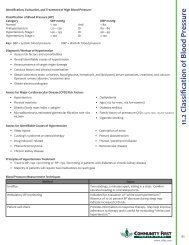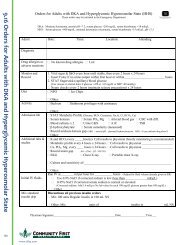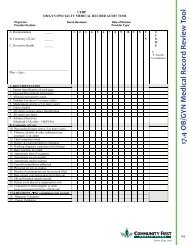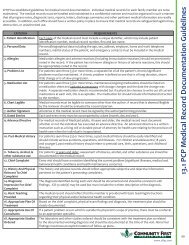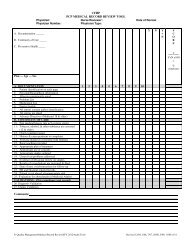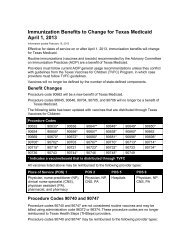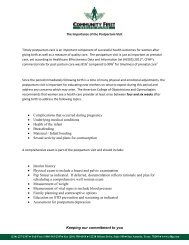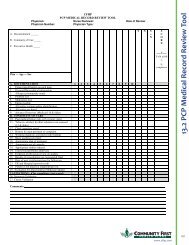Full Clinical Guidelines - Community First Health Plans.
Full Clinical Guidelines - Community First Health Plans.
Full Clinical Guidelines - Community First Health Plans.
You also want an ePaper? Increase the reach of your titles
YUMPU automatically turns print PDFs into web optimized ePapers that Google loves.
The following variables should be examined when cesarean deliveries are performed:<br />
• When cervical dilation was less than 4 cm<br />
• In the presence of intact membranes<br />
• Without appropriate use of oxytocin<br />
• After the patient has received an epidural when cervical dilation was less than 4 cm<br />
• After the patient has undergone elective induction of labor at less than 41 completed weeks of gestation<br />
• Without trial of labor for suspected macrosomia in nondiabetic women<br />
• For failed induction of labor for suspected macrosomia in nondiabetic women<br />
• For the sole indication of twin gestation<br />
• For the indication of termed fetuses with breech presentations, without offering eternal cephalic version<br />
Taken from the Evaluation of Cesarean Delivery, American College of Obstetricians and Gynecologists, pages 34-35, 2000<br />
ELECTIVE REPEAT CESAREAN SECTION GUIDELINES<br />
Before elective repeat cesarean delivery, the maturity of the fetus should be established. For patients with an indication for an<br />
elective repeat cesarean delivery, fetal maturity may be assumed if one of the following criteria is met:<br />
• Fetal heart tones have been documented for 20 weeks by nonelectronic fetoscope or for 30 weeks by Doppler ultrasound.<br />
• Thirty-six weeks have elapsed since positive results were obtained from a serum or urine human chorionic gonadotropin<br />
pregnancy test performed by a reliable laboratory.<br />
• Ultrasound measurement of the crown-rump length obtained at 6-11 weeks of gestation supports a current gestational age<br />
of 39 weeks or more.<br />
• <strong>Clinical</strong> history and physical and ultrasound examinations performed at 12-20 weeks of gestation support a current<br />
gestational age of 39 weeks or more.<br />
These criteria are not intended to preclude the use of menstrual dating. If any one criterion confirms gestational age<br />
assessment in a patient who has normal menstrual cycles and no immediate antecedent use of oral contraceptives, it is<br />
appropriate to schedule delivery at 39 weeks of gestation or later on the basis of menstrual dates.<br />
Taken from guidelines for Perinatal Care, Sixth Edition, American Academy of Pediatrics and American College of Obstetricians and Gynecologists, page 160<br />
October 2007<br />
17.2 Cesarian Section <strong>Guidelines</strong><br />
VAGINAL BIRTH AFTER CESAREAN DELIVERY GUIDELINES<br />
Despite extensive data regarding the risks and success rates of vaginal birth after cesarean delivery (VBAC), there is relatively<br />
little information regarding how labor should be conducted:<br />
• External cephalic version for breech presentation may be as successful for VBAC candidates as for women who have not<br />
undergone previous cesarean delivery.<br />
• The use of prostaglandins for cervical ripening or labor induction in VBAC candidates is discouraged. If induction of labor<br />
is necessary for a clear and compelling clinical induction, the potential increased risk of uterine rupture with the use of<br />
prostaglandins should be discussed with the patient and documented in the medical record.<br />
• Oxytocin may be used for both labor induction and augmentation with close patient monitoring in VBAC candidates.<br />
• Once labor has begun, the patient should be evaluated promptly. Most authorities recommend continuos electronic<br />
monitoring of both fetal heart rate and uterine contractions. The most common sign of uterine rupture is a nonreassuring<br />
fetal heart rate pattern with variable decelerations that may evolve into late decelerations, bradycardia, and undetectable<br />
fetal heart rate. Personnel familiar with the potential complications of VBAC should be vigilant for nonreassuring fetal<br />
heart rate patterns and inadequate progress in labor. Because uterine rupture may be catastrophic and evolve rapidly,<br />
VBAC should be attempted in institutions equipped to respond to emergencies with physicians immediately available to<br />
provide emergency care.<br />
• Epidural analgesia and anesthesia may safely be used during a trial of labor and planned VBAC. Assurance of adequate pain<br />
relief during labor may encourage more women to choose a trial of labor. Success rates for VBAC are similar in women<br />
who do and those who do not receive epidural analgesia, as well as in those women who receive other types of pain<br />
relief. Epidural analgesia rarely masks the signs or symptoms of uterine rupture. The anesthesia service should be notified<br />
whenever there is a patient attempting VBAC in active labor on the labor floor.<br />
Taken from guidelines for Perinatal Care, Sixth Edition, American Academy of Pediatrics and American College of Obstetricians and Gynecologists, pages 156-157,<br />
October 2007<br />
H EALTH PLANS<br />
www.cfhp.com<br />
145



